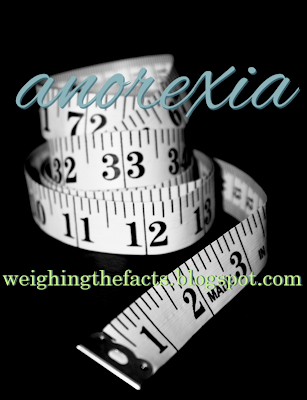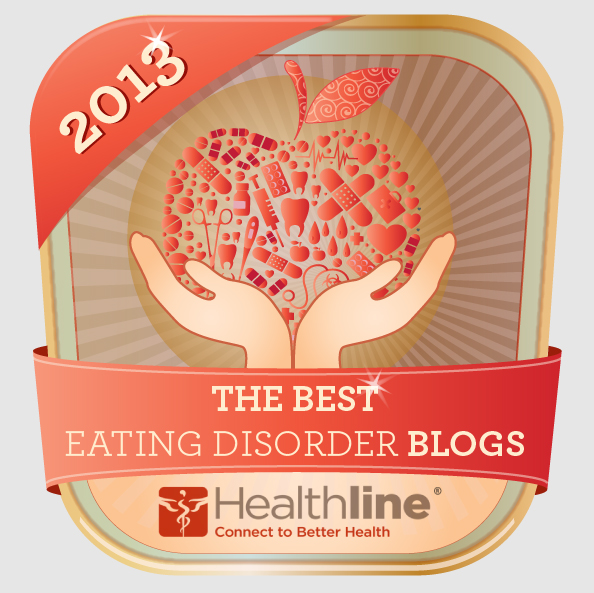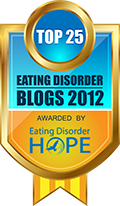Wikipedia : "Anorexia Nervosa is a psychiatric diagnosis that describes an eating disorder characterized by low body weight and body image distortion with an obsessive fear of gaining weight. Individuals with anorexia are known to commonly control body weight through the means of voluntary starvation, purging, vomiting, excessive exercise, or other weight control measures, such as diet pills or diuretic drugs. It primarily affects adolescent females, however approximately 10% of people with the diagnosis are male. Anorexia nervosa is a complex condition, involving psychological, neurobiological, and sociological components."
There are many contributing factors that can lead to an eating disorder. Some of these are biological, cultural, social, and so on. Though different people develop an eating disorder for different reasons there are some common aspects.
Most who suffer with Anorexia tend to be perfectionistic with a strong need to control everything in their lives. Though high achieving they often feel deficient and powerless. They are inclined to have unrealistic expectations of both themselves and others. They frequently lack a sense of identity, relying on presenting a socially admired and accepted exterior to define themselves. Achieving what others are unable to, they feel a sense of pride and see their anorexia as a badge of honor. Their need for approval and their fear of criticism can result in anger. Unable to express that anger in a productive way it is turned inward, and they either starve or stuff themselves.
"Some people with eating disorders use the behaviors to avoid sexuality. Others use them to try to take control of themselves and their lives. They want to be in control and in charge. They are strong, usually winning the power struggles they find themselves in, but inside they feel weak, powerless, victimized, defeated, and resentful."
"In addition, they see the world as black and white, no shades of gray. Everything is either good or bad, a success or a failure, fat or thin. If fat is bad and thin is good, then thinner is better, and thinnest is best -- even if thinnest is sixty-eight pounds in a hospital bed on life support," according to ANRED: what causes eating disorders.
"Anorexia nervosa was not officially classified as a psychiatric disorder until the third edition of DSM in 1980. It is, however, a growing problem among adolescent females. Its incidence in the United States has doubled since 1970. The rise in the number of reported cases reflects a genuine increase in the number of persons affected by the disorder, and not simply earlier or more accurate diagnosis. Estimates of the incidence of anorexia range between 0.5-1% of caucasian female adolescents. Over 90% of patients diagnosed with the disorder as of 1998 are female. It was originally thought that only 5% of anorexics are male, but that estimate is being revised upward. The peak age range for onset of the disorder is 14-18 years, although there are patients who develop anorexia as late as their 40s. In the 1970s and 1980s, anorexia was regarded as a disorder of upper- and middle-class women, but that generalization is also changing. More recent studies indicate that anorexia is increasingly common among women of all races and social classes in the United States," states an article at Health A to Z.
The article goes on to say, "Anorexia nervosa is a serious public health problem not only because of its rising incidence, but also because it has one of the highest mortality rates of any psychiatric disorder. Moreover, the disorder may cause serious long-term health complications, including congestive heart failure, sudden death, growth retardation, dental problems, constipation, stomach rupture, swelling of the salivary glands, anemia and other abnormalities of the blood, loss of kidney function, and osteoporosis."
"The rising incidence of anorexia is thought to reflect the present idealization of thinness as a badge of upper-class status as well as of female beauty. In addition, the increase in cases of anorexia includes "copycat" behavior, with some patients developing the disorder from imitating other girls."
"The onset of anorexia in adolescence is attributed to a developmental crisis caused by girls' changing bodies coupled with society's overemphasis on women's looks. The increasing influence of the mass media in spreading and reinforcing gender stereotypes has also been noted."
EHealth MD/ Warning Signs of Anorexia:
See Also: Anorexia: Mortality Rates
- Excessive weight loss or lack of normal weight gain, often to the point of starvation
- Intense fear of gaining weight or becoming fat
- Distorted image of body weight or shape
- Absence of at least three menstrual periods in a row in females
- Significant reduction of the amount of food eaten
- Avoiding eating; skipping meals
- Intense focusing on food, eating, and body weight and shape
- Repeatedly weighing oneself
- Denial of hunger
- Rigid eating patterns, such as extreme controlling of calories and fat even when underweight
- Unusual rituals at mealtimes, such as cutting food into tiny pieces, moving food around the plate, and throwing out food so it does not have to be eaten
- Storing or hoarding food
- Collecting recipes and cooking for others while finding excuses to avoid eating
- Wearing baggy clothes to hide the amount of weight lost
- Obvious fear or anxiety before eating and guilt after eating
- Complaining of bloating and unusual fullness after eating only small amounts of food
- Excessive or compulsive exercising
Anorexia and Osteoporosis
See sidebar for ED Resources, Hotlines, Recovery
picsourcehttp://www.flickr.com/photos/pinksherbet/3209939998/



 0
comments
0
comments



















